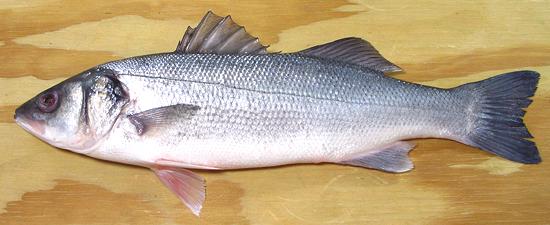 [Branzino (Italy, Restaurants); Dicentrarchus labrax]
[Branzino (Italy, Restaurants); Dicentrarchus labrax]
This Seabass is native to Western Europe and northwestern Africa. It is common along the north coast of Norway, in the North Sea, around the British Isles, southern Iceland, and the Atlantic coasts of France, Spain, Morocco and Senegal. It is reasonably common in the Western Mediterranean and the north Adriatic, but relatively scarce in the Eastern Mediterranean. It is moderately common in the Black Sea.
This fish can grow to 40 inches and 26 pounds, but is typically 20 inches. The photo specimen, farm raised in Turkey, was 13-1/4 inches long and weighed 14 ounces. This fish is IUCN rated LC (Least Concern).
More on Bass Family.
European Seabass is and excellent mild eating fish. In North America it is served in expensive restaurants as "Branzino", because any chef worth his toque knows, he can get three times the price than if he calls it "Bass". It is often served whole on an oval plate with artistically applied garnishes.
The flesh is light in color, light in flavor without being bland, and tender. It doesn't really flake apart, rather it just breaks up almost randomly. The flesh is almost white with a wide thin darker layer just under the skin. This darker layer is only slightly stronger in taste, and so thin it is not a significant factor.
Though fillets (skin off) can withstand a short poaching, this fish is not otherwise suitable for wet cooking - it will quickly disintegrate. The most usual ways to prepare this fish are grilled, pan roasted or steamed - whole or pan dressed. It is often stuffed with lemons and herbs. Fillets can also be pan fried skin-on or skin-off. I prefer skin-on as the skin contributes a bit of texture and flavor.
For any of the above methods (except fillets), the skin should have shallow, diagonal gashes so it does not tear. The gashes will open some, but not unattractively.
When frying skin-on fillets, you definitely want at least a light powdering of rice flour to prevent sticking to the pan and to keep the skin in place. Once it's been heated the skin has almost no grip on the flesh and will otherwise peel right off and make a mess. Pan fry skin side up until the fillet is stiffened, then flip it skin side down to finish.
Buying: This fish has recently become available in the Asian fish markets here in Los Angeles. Restaurants buy such fish directly from fish wholesalers, who don't sell to public markets until they have more than the restaurants can buy. This is a premium priced fish. the photo specimen was purchased as "Branzino" from a large Asian market in Los Angeles (San Gabriel) for 2018 US $5.99 / pound.
Scales: This fish is completely covered with medium size scales with good adhesion, so they take a little effort to scrape off, but they don't fly around a lot.
Cleaning: This fish is fairly easy to clean, but there is a swim bladder and some internal membranes that are a bit tough. Some of the innards are difficult to pull out until you pull the gills. The gills are in fairly hard, so use your long nose pliers.
Fillet: This is an easy fish to fillet, having an orderly bone structure to follow. Make cuts over the tail and on the underside from tail to body cavity. Cut from front to back down to the backbone on both sides, then hop over the backbone at the tail and work forward to the rib cage. Cut the ribs from the backbone with kitchen shears and pull them from the fillet with long nose pliers - they pull easily taking little flesh. There are some centerline pin bones to be pulled out straight forward for half the length of the body cavity, and one short one at the front of the skirt.
Skin: The skin has flavor a little stronger than the flesh, but not much, so it can be tossed in the pot with the bones, heads and fins for fish stock. Shrink is moderate, but enough to curl a fillet in the frying pan. You can fry fillets skin-on if you dust them lightly with rice flour. First fry skin side up, then turn the fillets over and press them flat with your turner until the skin looses its grip, just a few seconds. The skin can be left on for most suitable forms of cooking, but not for poaching fillets. Fillets can be skinned quite easily by the long knife and cutting board Method.
Yield: A 14-3/4 ounce 13-1/2 inch fish yielded 7-1/2 ounces of fillet skin-on (51%) and 6.6 ounces with the skin removed (45%). Smaller fish may yield a little less.
Stock: The head, bones, fins and any removed skins make a pleasant, usable, almost clear fish stock with little oil, but do remove what oil there is using your gravy separator. For details see our recipe Making Fish Stock.
sf_bassstz 061010 - www.clovegarden.com